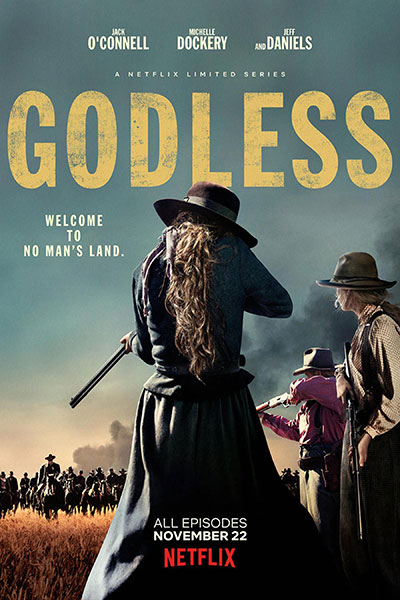NETFLIX’S “Godless” is a Western television show – wild, violent, bloody, and in the same traditional vein of the Western film as any of those old ones (Stagecoach, Once Upon a Time in the West, Shane, A Fistful of Dollars, etc.) that the adult men in my family used to be so fond of watching when I was a child. In fact, there are many callbacks to those old movies and a general sense of an homage to the Western film when one watches “Godless”, so that it begs the question, how on earth can this brutal TV show be a good way to bring in the new year?
 The New Year is about change, growth, and hope for whatever the future brings your way. “Godless” itself highlights many of these ideas from an artistic point of view, but even from the perspective of a child who hated Westerns, while everyone else who surrounded me back then lapped them up, “Godless” and the way I am in awe and in love with this show represents the way our ideas about things and our reactions to things can change as the years go by – and this is significant because change, after all, is one of the most dominant facets regarding the New Year that we all begin to contemplate as December comes to an end.
The New Year is about change, growth, and hope for whatever the future brings your way. “Godless” itself highlights many of these ideas from an artistic point of view, but even from the perspective of a child who hated Westerns, while everyone else who surrounded me back then lapped them up, “Godless” and the way I am in awe and in love with this show represents the way our ideas about things and our reactions to things can change as the years go by – and this is significant because change, after all, is one of the most dominant facets regarding the New Year that we all begin to contemplate as December comes to an end.
I like to wonder what my grandfather would have thought of “Godless” had he lived to see it. As mentioned before, there are many references to iconic Westerns, but “Godless” is something unique and something very current, particularly in the ways that it manages to pay homage to, while usurping, and changing/updating features of the traditional Western for the millennial demographic. Change is inevitable. Both years and Westerns are caught up in the concept.
For example, and of major interest, is the way race is dealt with in “Godless.” Sometimes, Western movies forget that black people and Native American peoples were present during the times the movies were set. In “Godless” race is explored in several ways. There are two interracial relationships that are crucial to the developments in the story, and several coloured characters who play vital roles.
In the show not only are coloured characters represented but their relationships with the white characters, as well as their own sense of place, and their ideas of who they are explored in the show. With #OscarsSoWhite and people of colour generally calling for more inclusivity in film and television this past year, “Godless” gives an impression of what the beginning of a change in genres that are often very white can look like if other aspects of the scenario being explored in a film or TV show can be tapped into.
Secondly, we have the premise of “Godless” itself. After an accident in the town of LaBelle has left almost all of the men dead (because they worked in the mines where the accident occurred), the town is primarily occupied by and run by the womenfolk who survived. In this very outline, we can see how “Godless” differs from a majority of the old Western films that were produced in the past.
“Godless” is very much a woman-centric Western, with most of the primary characters being fully-developed, interesting women-characters. In the TV show, the prostitute (played beautifully by Tess Frazer), who was often sidelined in old Westerns and restricted to flirtatious, eye-candy parts, is here realised as the richest woman in town, bisexual, and one of the bravest of them all when it comes to the final showdown at the end of the series. This is just one example of how the women in the show have been written with the modern era of television audiences in mind.
The braveness, cunning and skills exemplified by women in the show, particularly when compared to the bumbling male sheriff or other male characters who fail and fumble, ensures that the women of “Godless” highlight the fully-realised women figures of the times, while simultaneously being entertaining and ensuring that ideas of how women are treated and represented in the media (particularly film and television) when compared to past depictions remains one of the primary things in the minds of the audience as we move into the new year.
The women of LaBelle unknowingly harboured a criminal named Roy Goode (played by the excellent Jack O’Connell) who has betrayed the leader of the band of outlaws that he was previously a part of. The outlaws and their terrifying leader, Frank Griffin (played by Jeff Daniels) hunt Roy down, murdering everyone in their path. As the outlaws made their way to the town of Labelle, populated by women and children, it quickly becomes clear that the women are in great danger and they are forced to both arm and defend themselves. With Roy and Frank, we get the hero and the villain of the story – except that with “Godless”, it’s more like the antihero and the villain.
Roy has done bad things in his past, and Frank, for all his fearsome villainy, expresses moments of kindness throughout the series. Both of these characters are, in a sense, of ambiguous morality. Yes, in broad strokes we can identify one as bad and one as evil, but how do we account for the inclusion of the grey strokes of evil in the good character and the moments of goodness in the evil one? Characters such as these have become more prevalent in film and television over recent years (Game of Thrones harbours quite a few of them), and the reasons for this surge are unknown to me. However, what is fascinating is the way the character of ambiguous morality is the character who represents the truest form of human nature.
Noone is 100 per cent good, nor is noone all bad. Characters that exist in this in-between are, for me, the most realistic, the most realised and, therefore, the most affecting, characters. It is my wish that in 2018, Guyanese writers choose to abandon the character written in broad strokes that we know from fairy tales (characters like the “good” prince, “wicked” witch, etc.) and pay more attention to creating the grey characters, or in-between characters, or characters with ambiguous morality.
It is human nature to be flawed and to remove the flaws from your heroes and to heap flaws on to your villains, in this time and age seems to be a very reductive move to make when it comes to character development in the 21st Century. For all these reasons, and more, “Godless” should be at the very top of the list of shows you watch in the New Year.




.png)









